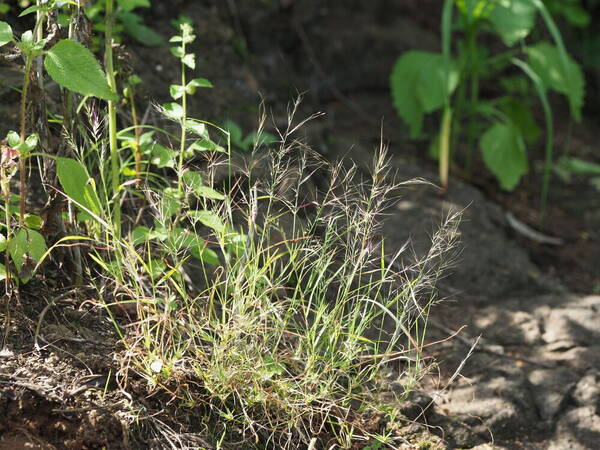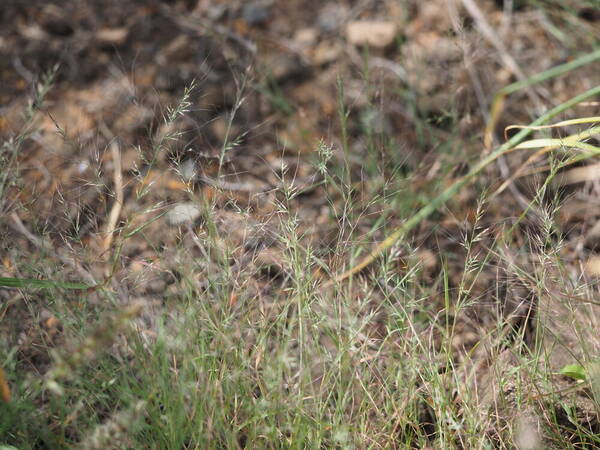Info
Subfamily: Chloridoideae
Genus etymology: Muhlenbergia = honorific for Gotthilf Heinrich Ernst Muhlenberg (1753–1815)
Species etymology: microsperma = "small seed" [Greek] refering to the size of the seeds
Photosynthetic type: C4 (warm season)
Nativity: naturalized - accidental
First recorded in Hawaiʻi: 1907
Map

Inflorescence




Plant


Habit


Spikelets

Culm base

Description
Plants annual, sometimes appearing as short-lived perennials; tufted. Culms 10-80 cm, often geniculate at the base, much branched near the base; internodes mostly scabridulous or smooth, always scabridulous below the nodes. Sheaths often shorter than the internodes, glabrous, smooth or scabridulous; ligules 1-2 mm, membranous to hyaline, truncate to obtuse; blades 3-8.5(10) cm long, 1-2.5 mm wide, flat or loosely involute, scabrous abaxially, strigulose adaxially. Panicles 6.5-13.5 cm long, 1-6.5 cm wide, not dense, often purplish; branches 1.6-4 cm, ascending or diverging up to 80° from the rachises, spikelet-bearing to the base; pedicels 2-6 mm, appressed to divaricate, antrorsely scabrous; disarticulation above the glumes. Spikelets 2.5-5.5 mm, borne singly. Glumes 0.4-1.3 mm, exceeded by the florets, 1-veined, obtuse, often minutely erose; lower glumes 0.4-1 mm; upper glumes 0.6-1.3 mm; lemmas 2.5-3.8(5.3) mm, narrowly lanceolate, mostly smooth, scabridulous distally, hairy on the calluses, lower 1/2 of the margins, and midveins, hairs 0.2-0.5 mm, apices acuminate, awned, awns 10-30 mm, straight to flexuous; paleas 2.2-4.8 mm, narrowly lanceolate, acuminate; anthers 0.3-1.2 mm, purplish. Caryopses 1.7-2.5 mm, fusiform, reddish-brown. Cleistogamous panicles with 1-3 spikelets present in the axils of the lower leaves. 2n = 20, 40, 60.
(Description source: Barkworth, M.E., Capels, K.M., Long, S. & Piep, M.B. (eds.) 2003. Flora of North America, north of Mexico. Volume 25. Magnoliophyta: Commelinidae (in part): Poaceae, Part 2. Oxford University Press, New York. 783 pp. http://floranorthamerica.org/Muhlenbergia_microsperma )
Tufted annuals; culms wiry, widely ascending, 6-30 cm tall, often geniculate, nodes scurfy pubescent, lower internodes exposed, profusely branched, the lower branches with clusters of cleistogamous spikelets. Sheaths 1-5 cm long, glabrous; ligule ca. 1 mm long, membranous, lacerate; blades 2.5-3 cm long, 1-2 mm wide, scabrous. Panicles narrow, erect, 4-13 cm long, with 1-2 cm of the lower part usually enclosed within the sheath, branches ascending, widely spaced, 3-6 cm long, glabrous, scabrous, or hispid; spikelets 2-2.5 mm long; glumes unequal, membranous, glabrous, 1-nerved, apex rounded to obtuse, first glume ca. 0.7 mm long, second glume ca. 1 mm long; lemma 2-2.5 mm long, 3-nerved, silky pubescent at base and minutely scaberulous toward apex, the awn slender, 9-14 mm long, scabrous, arising from the bifid apex; palea ca. 2 mm long, 2- nerved, lower 2 silky pubescent, upper minutely scaberulous; cleistogamous spikelets 3-6 per fascicle, 1-flowered, narrowly ovoid, 4-6 mm long, glumes many-nerved, indurate, thickened, glabrous, apex acute reddish brown, cylindrical, ca. 2 mm long, caryopsis of cleistogamous florets thicker.
(Description source: O’Connor, P.J. 1990. Poaceae, pp. 1481–1604. In: Wagner W.L., Herbst D.R. & Sohmer S.H. (eds.)., Manual of the flowering plant of Hawaiʻi. Vol. 2. University of Hawaii Press & Bishop Museum Press, Honolulu )